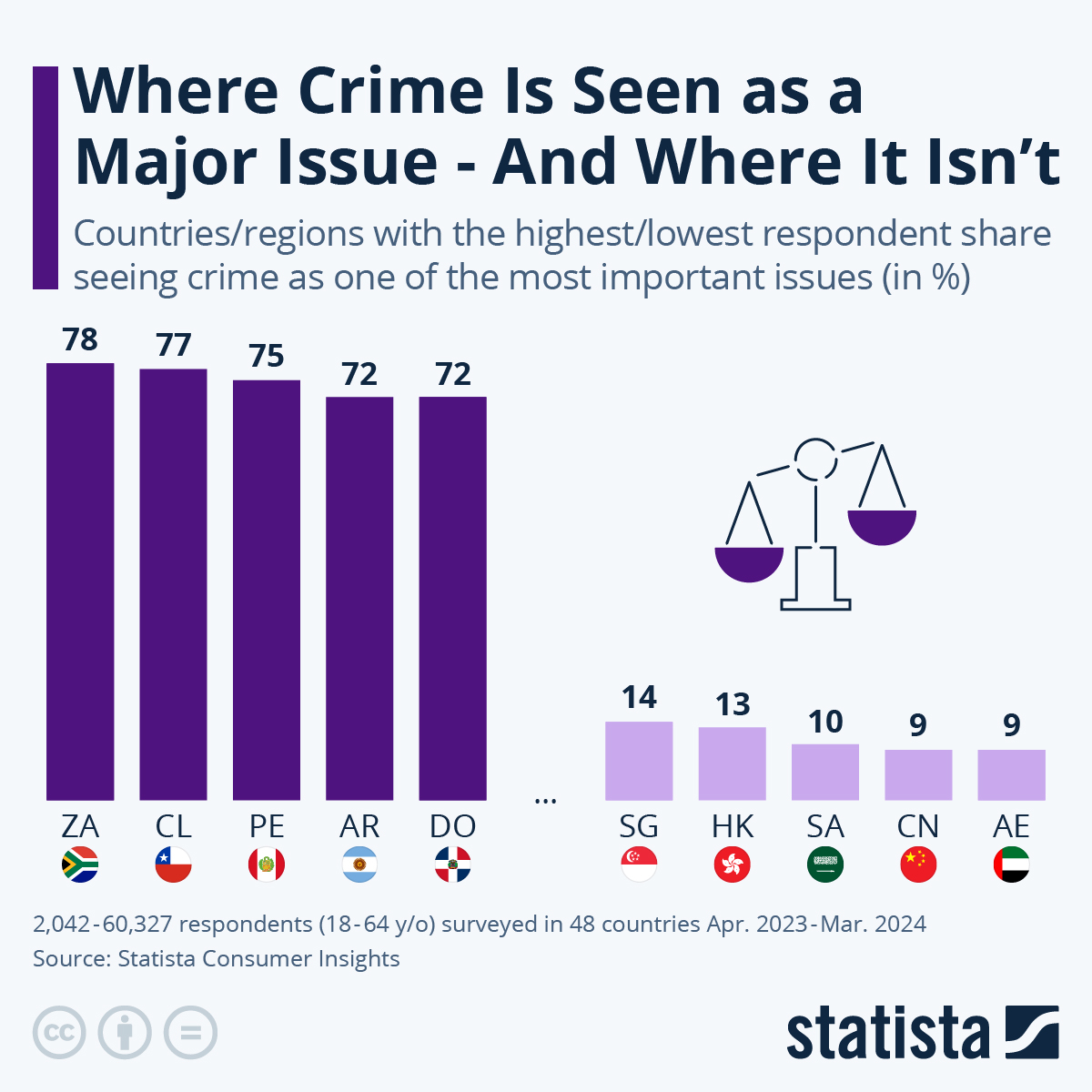
Data from the 2024 Global Peace Index released by the Institute for Economics and Peace shows that the world has become increasingly less peaceful over the past decade and a half.
This is largely due to the indicator group Ongoing Conflict, which deteriorated by almost 20 percent since 2008, according to the index authors.
Other indicators like the terrorism impact and homicide rates, however, have significantly improved over the same period, especially in the Americas.
As Statista's Florian Zandt reports, a recent Consumer Insights survey shows that crime is still on the minds of many residents of Latin American countries, even though the questionnaire was not specifically targeted toward the respondents' feelings about violent crimes like murder.
Out of the five countries with the highest share of survey participants seeing crime as a major issue in their country, four were situated on the American continent, with South Africa taking the top spot with 78 percent.
You will find more infographics at Statista
Some of the world's biggest economies are situated in the midfield of the 48 countries surveyed. Germany, for example, has 34 percent of respondents who answered that crime is an issue that needs to be tackled. In the United States, France and the United Kingdom, the shares stood at 42, 38 and 36 percent, respectively. Looking only at highly industrialized, so-called Western countries, Sweden claimed the top spot with 61 percent. This notion might be related to increased migration to the Northern European country after 2015. In 2023, Sweden tied with Ireland in the share of residents born in a non-EU country, according to Eurostat data.
On the low end of the spectrum are five countries and regions in Asia and the Middle East. China and the United Arab Emirates are the only states where less than ten percent of respondents see crime as an issue. Other places in these geographic regions rank considerably higher on the list. For example, South Korea, Thailand, Taiwan and Japan reported shares of 31, 31, 30 and 24 percent, respectively.
Data from the 2024 Global Peace Index released by the Institute for Economics and Peace shows that the world has become increasingly less peaceful over the past decade and a half.
This is largely due to the indicator group Ongoing Conflict, which deteriorated by almost 20 percent since 2008, according to the index authors.
Other indicators like the terrorism impact and homicide rates, however, have significantly improved over the same period, especially in the Americas.
As Statista’s Florian Zandt reports, a recent Consumer Insights survey shows that crime is still on the minds of many residents of Latin American countries, even though the questionnaire was not specifically targeted toward the respondents’ feelings about violent crimes like murder.
Out of the five countries with the highest share of survey participants seeing crime as a major issue in their country, four were situated on the American continent, with South Africa taking the top spot with 78 percent.
You will find more infographics at Statista
Some of the world’s biggest economies are situated in the midfield of the 48 countries surveyed. Germany, for example, has 34 percent of respondents who answered that crime is an issue that needs to be tackled. In the United States, France and the United Kingdom, the shares stood at 42, 38 and 36 percent, respectively. Looking only at highly industrialized, so-called Western countries, Sweden claimed the top spot with 61 percent. This notion might be related to increased migration to the Northern European country after 2015. In 2023, Sweden tied with Ireland in the share of residents born in a non-EU country, according to Eurostat data.
On the low end of the spectrum are five countries and regions in Asia and the Middle East. China and the United Arab Emirates are the only states where less than ten percent of respondents see crime as an issue. Other places in these geographic regions rank considerably higher on the list. For example, South Korea, Thailand, Taiwan and Japan reported shares of 31, 31, 30 and 24 percent, respectively.
Loading…





